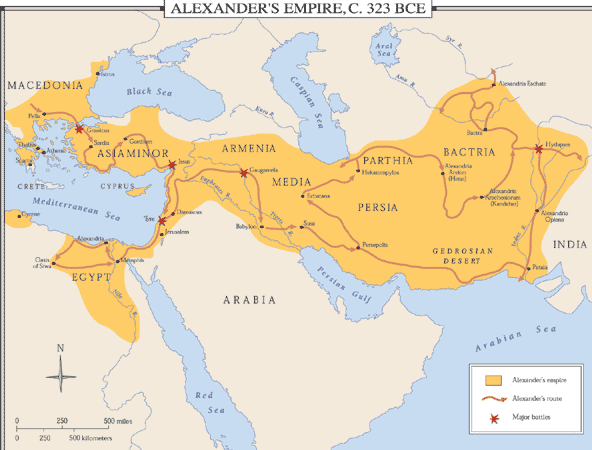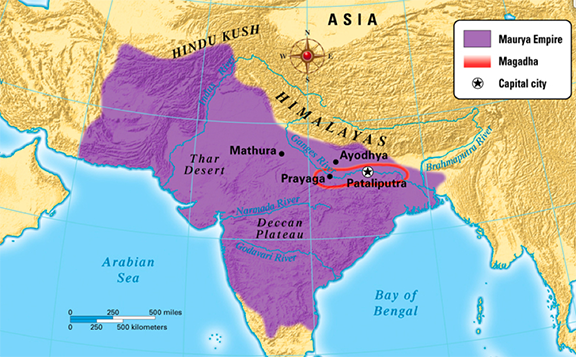Great Ancient Kings: Alexander & Chandragupta | 22 Nov 2021
Why in News
Recently, Uttar Pradesh Chief Minister said that Chandragupta Maurya had defeated Alexander and yet, it is the latter whom historians have chosen to call great.
- Alexander was referred to as great by early historians. Similarly in Indian history, ‘great’ has been used for the emperors Ashoka, Rajaraja and Rajendra Chola, and Akbar, among others.
- However, later historians have moved their focus away from the political triumphs of individual rulers to the society, economy, art and architecture of their times.
Key Points
- Reason for Greatness of Kings:
- Alexander:
- Because of his stupendous military conquests which amazed European writers and chroniclers of the ancient world.
- He had established, before he turned 30 years of age, the largest empire (323 B.C.) the world had seen until then, which stretched across modern western and central Asia all the way from Greece to India’s northwestern frontier.
- Chandragupta Maurya:
- He was the architect of the Mauryan empire (321 B.C - 185 B.C) that controlled the plains of both the Indus and the Ganga, and which stretched until the eastern and western oceans.
- With Pataliputra at its imperial centre, the Mauryan Empire for the first time unified most of South Asia.
- He laid the foundations of an extensive and efficient system of centralised administration and tax-collection that formed the bases of his empire.
- Trade and agriculture were reformed and regulated with the building of infrastructure and standardisation of weights and measures, and provisions were made for a large standing army.
- He was the architect of the Mauryan empire (321 B.C - 185 B.C) that controlled the plains of both the Indus and the Ganga, and which stretched until the eastern and western oceans.
- Chola Emperors:
- The Chola emperors Rajaraja I (985-1014) and Rajendra I (1014-1044) built strong navies that conquered the Maldives, and reached Sri Lanka and several countries of Southeast Asia across the Bay of Bengal.
- Ghenghis Khan & Others:
- Ghenghis Khan (1162-1227) stamped his authority over a bigger swathe of Asia and Europe, and other conquerors such as Tamerlane, Atilla the Hun, and Charlemagne, as well as Ashoka, Akbar, and Aurangzeb built their own very large empires.
- Alexander:
Alexander (356-323 BC)
- About:
- Alexander was born in 356 BC at Pella in ancient Greece, and succeeded his father, king Phillip II, to the throne at the age of 20.
- Over the next 10 years, Alexander led campaigns across large parts of West Asia and North Africa.
- In 330 BC, he defeated Darius III in the decisive battle of Gaugamela, and after a long campaign in Bactria in the region of the Amu Darya north of today’s Afghanistan, he crossed the Hindu Kush and entered the Kabul valley.
- Alexander was born in 356 BC at Pella in ancient Greece, and succeeded his father, king Phillip II, to the throne at the age of 20.
- Indian Campaign:
- In 326/327 BC, Alexander crossed the Indus, the farthest frontier of the old Persian empire, and began his Indian campaign that lasted about two years.
- The king of Taxila surrendered to Alexander, but beyond the Jhelum he was challenged by the legendary warrior whom Greek sources have identified as Porus.
- In the battle of Hydaspes that followed, Alexander won, but following his famous interview with Porus — during which the wounded king is said to have demanded that the invading emperor treat him “as befits a king” — was impressed enough to return to the captive Porus his kingdom, and to leave him in charge of Punjab when the Greek army ultimately retreated.
- Retreat:
- After the defeat of Porus, Alexander wished to march on into the heartland of the Gangetic basin — but upon reaching the Beas, the last of the five rivers of Punjab, his generals refused to go further.
- Alexander was forced to turn back, and he followed the Indus southward to its delta, where he sent part of his army to Mesopotamia by sea, while leading the other part overland along the Makran coast.
- He reached Susa in Persia in 324 BC, and in the following year, died in the ancient city of Babylon, to the south of today’s Baghdad.
- His aborted Indian campaign notwithstanding, Alexander is believed to have died undefeated in any battle — seemingly fulfilling the prophecies that he would conquer the entire world.
- At the time Alexander turned back from the threshold of India, his army was tired and homesick, they had wearied of fighting in the heavy Indian monsoon, and it is possible they were intimidated by stories of two great armies that lay in wait for them ahead:
- That of the Nandas of Magadha (c. 362 BC-321 BC), comprising, according to Greek writers, at least 20,000 cavalry, 200,000 infantry, and 3,000 war elephants.
- And the Gangaridai empire corresponds to what is today West Bengal and parts of Bangladesh.
Chandragupta and Alexander
- Historians estimate the year of Chandragupta’s rise to power in a band stretching from 324 BC to 313 BC, however, it is generally accepted that he ascended the throne in 321 BC and died in 297 BC.
- Even accepting the least recent year for his accession would, however, place him after Alexander had left India — and just before the Greek emperor’s death in Babylon.
- Greek sources suggest that Chandragupta may have been in communication with Alexander during the latter’s Indian campaign.
- A L Basham’s The Wonder That Was India notes that “classical sources speak of a young Indian named Sandrocottus — identical with the Chandragupta Maurya of Indian sources.
- Plutarch states that Sandrocottus advised Alexander to advance beyond the Beas and attack the Nanda emperor, who was so unpopular that his people would rise in support of an invader.
- The Latin historian Justin adds that later Sandrocottus offended Alexander by the boldness of his speech and after many adventures succeeded in expelling the Greek forces and gaining the throne of India.
- Based on these accounts, Basham concluded that “it is reasonable to believe that the emperor Chandragupta Maurya, who rose to power soon after Alexander’s invasion, had at least heard of the conqueror, and perhaps derived inspiration from his exploits”.
Chandragupta
- About:
- Greek and Indian sources agree that Chandragupta overthrew the unpopular last king of the Nandas, Dhana Nanda, and occupied his capital, Pataliputra.
- Chandragupta is said to have been a protege of the Brahmin philosopher Kautilya who, having been insulted by the Nanda king, bore a grudge against him.
- Chanakya, also known as Kautilya and Vishnugupta, to whom is attributed the legendary Arthashastra, the pioneering Indian treatise on political science, statecraft, military strategy, and economy.
- Buddhist texts say Chandragupta Maurya belonged to the kshatriya Moriya clan associated with the Shakyas.
- Brahmanical texts, however, refer to the Mauryas as shudras and heretics.
- Guided by the guile and strategy of Kautilya and by his own great military prowess, Chandragupta went about fulfilling his imperial ambitions.
- Greek and Indian sources agree that Chandragupta overthrew the unpopular last king of the Nandas, Dhana Nanda, and occupied his capital, Pataliputra.
- Movement to North-West:
- He moved north-west to occupy the power vacuum left by the retreat of Alexander’s army.
- These areas fell to him rapidly, until he reached the Indus. Here he paused as the Greek Seleucus Nicator — the successor to Alexander — had fortified his hold on the area.
- Consequently, “Chandragupta moved to central India for a while, but 305 BC saw him back in the north-west, involved in a campaign against Selucus”, in which he was successful.
- By the peace treaty that was negotiated in 303 BC, some Seleucid territories that today would cover eastern Afghanistan, Balochistan, and Makran were ceded to the Maurya.
- Some matrimonial alliances followed as well, and during the campaign and afterward, there was considerable cultural contact between the Mauryans and the Greeks.
- With the treaty of 303 BC, the routes and nodal points of the north-west region shifted from Persian-Hellenistic to Mauryan control.


